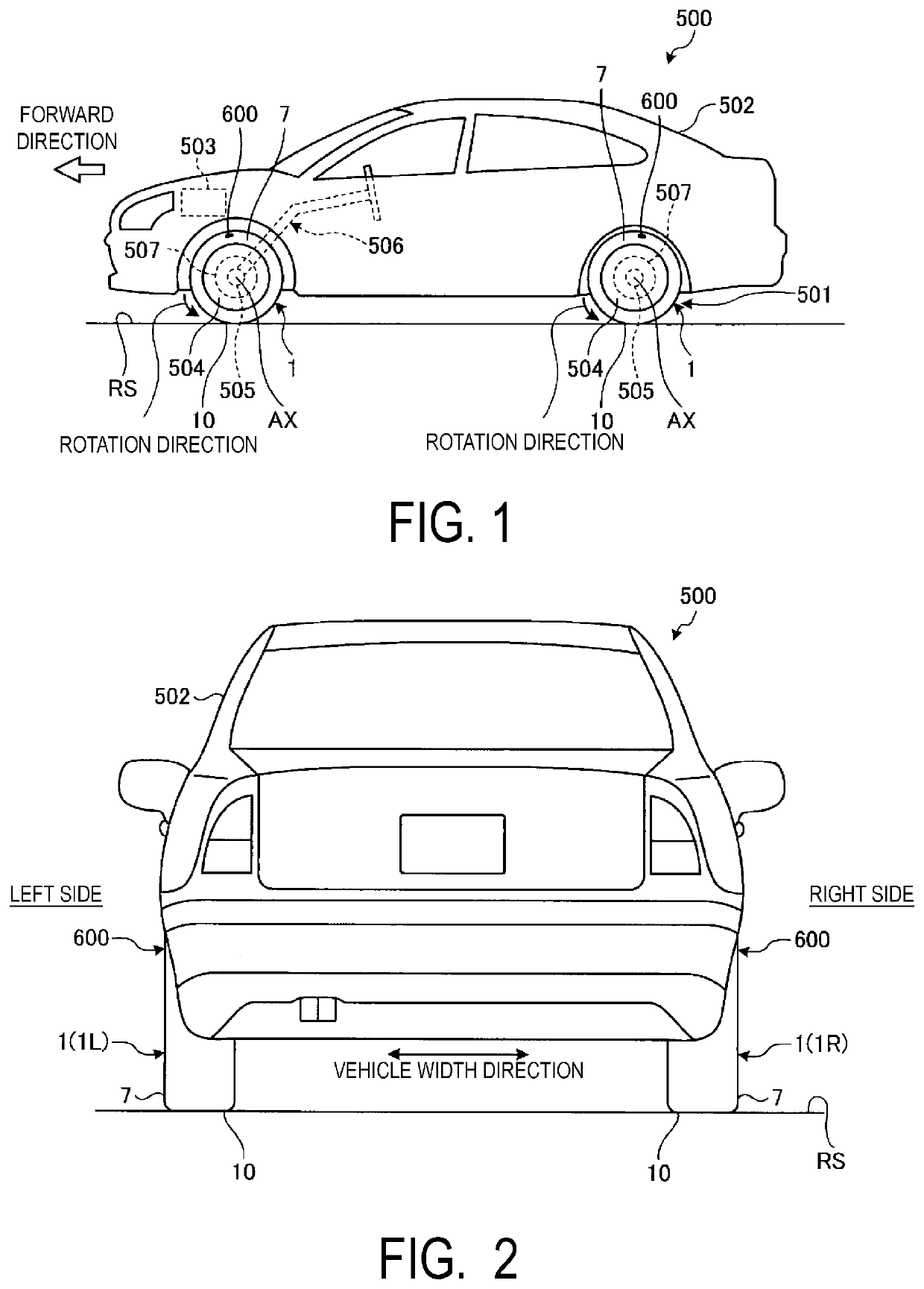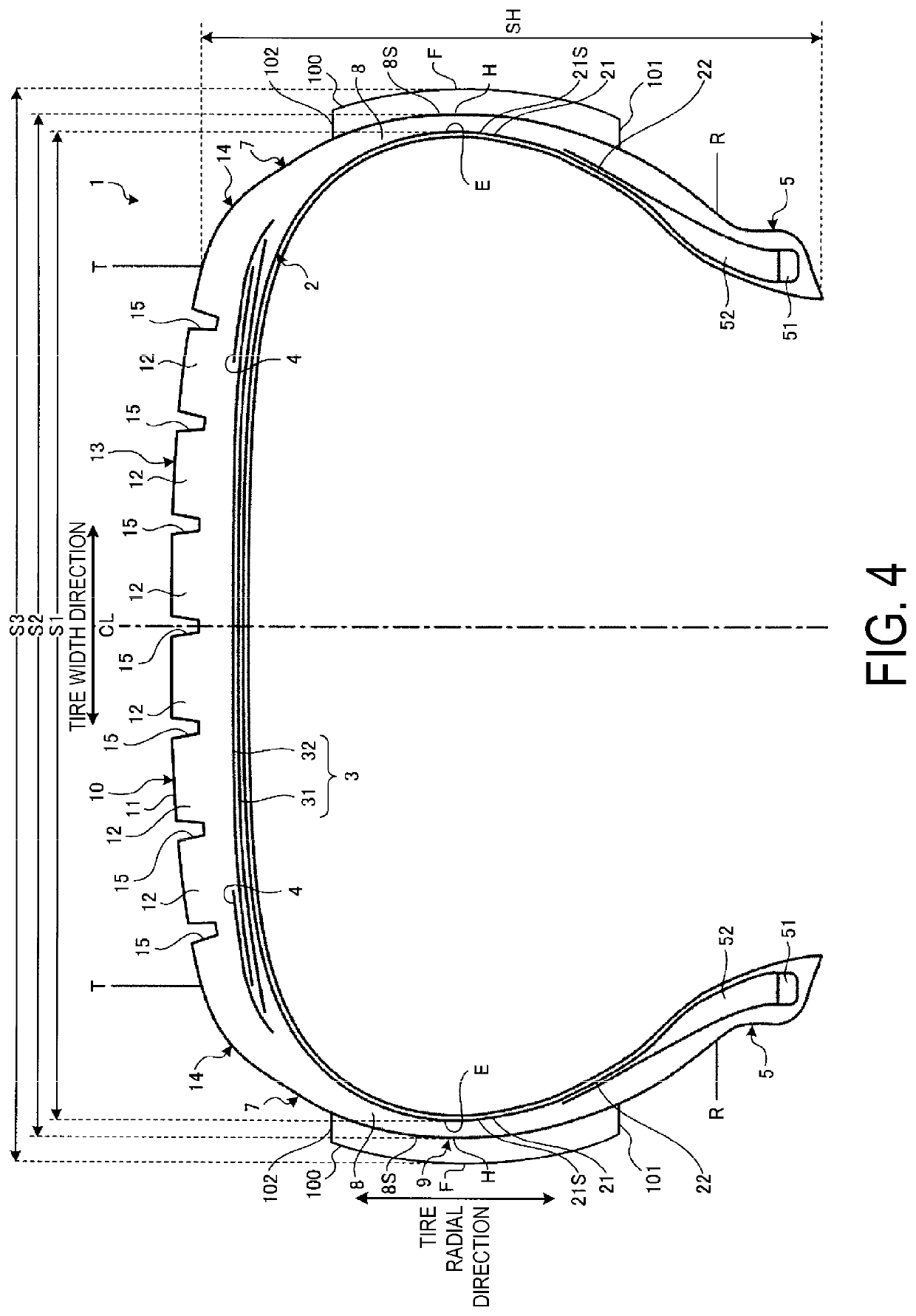Pneumatic tire
a pneumatic tire and tire body technology, applied in the field of pneumatic tires, can solve the problems of large distance between the outer surface of the carcass and the outer surface of the protruding portion, the rigidity and cut resistance of the pneumatic tire may deteriorate, and the air resistance at the maximum width position of the tire tends to become large, so as to achieve the effect of reducing the fuel efficiency of the vehicle, and reducing the air resistance of the vehicl
- Summary
- Abstract
- Description
- Claims
- Application Information
AI Technical Summary
Benefits of technology
Problems solved by technology
Method used
Image
Examples
first embodiment
[0063]A first embodiment will now be described. FIG. 1 is a side view illustrating an example of a vehicle 500 according to the present embodiment. FIG. 2 is a rear view of the vehicle 500 according to the present embodiment. Tires 1 are mounted on the vehicle 500. The tires 1 are pneumatic tires. The tires 1 mounted on the vehicle 500 rotate about a rotation axis AX and travel on a road surface RS.
[0064]Herein, a tire circumferential direction, a tire radial direction, and a tire width direction will be used as terms to explain the positional relationships between the components. The tire circumferential direction refers to a rotation direction about the rotation axis AX of the tire 1. The tire radial direction refers to a radiation direction out from the rotation axis AX of the tire 1. The tire width direction refers to a direction parallel with the rotation axis AX of the tire 1.
[0065]As illustrated in FIG. 1 and FIG. 2, the vehicle 500 is provided with a driving apparatus 501 th...
modified examples
[0121]In the tire 1 provided with the protrusion portions 100, the distance W1, the distance W2, and the distance W3 may be set so as to satisfy the following conditions:
0.80≤W1 / W3≤0.95 (3); and
1.0 mm≤G1≤2.5 mm (4).
[0122]When the condition (3) is satisfied, the weight reduction of the tire 1 is achieved while suppressing the deterioration in the rigidity and the cut resistance of the tire 1.
[0123]Further, when the condition (4) is satisfied, the weight reduction of the tire 1 is achieved while sufficiently protecting the carcass 2. A side rubber gage of a conventional tire is thicker than 2.5 mm. As a result of causing the distance G1 to be 2.5 mm or less through making it smaller than a conventional side rubber gage, the weight reduction of the tire 1 is achieved. When the distance G1 is smaller than 1.0 mm, the thickness of the side rubber 8 becomes too thin, and the carcass 2 is not sufficiently protected. As a result of the conditions (3) and (4) being satisfied, the weight re...
second embodiment
[0124]FIG. 8 is a diagram schematically illustrating the side surface 8S provided with the protrusion portions 100 according to the present embodiment. FIG. 9 is an enlarged view of a part of FIG. 8. As illustrated in FIG. 8 and FIG. 9, the protrusion portions 100 are inclined with respect to the radiating line LR from the rotation axis AX such that the first end portion 101 and the second end portion 102 have different positions from each other in the tire circumferential direction. In the example illustrated in FIG. 8 and FIG. 9, 12 protrusion portions 100 are provided.
[0125]Further, for each of the plurality of protrusion portions 100, directions in which the second end portions 102 are shifted with respect to the first end portions 101 are the same. Specifically, the inclination directions of the plurality of protrusion portions 100 are the same.
[0126]As a result of the longitudinal-shape protrusion portions 100 being disposed in the inclined manner, the carcass 2 is sufficientl...
PUM
 Login to View More
Login to View More Abstract
Description
Claims
Application Information
 Login to View More
Login to View More - R&D
- Intellectual Property
- Life Sciences
- Materials
- Tech Scout
- Unparalleled Data Quality
- Higher Quality Content
- 60% Fewer Hallucinations
Browse by: Latest US Patents, China's latest patents, Technical Efficacy Thesaurus, Application Domain, Technology Topic, Popular Technical Reports.
© 2025 PatSnap. All rights reserved.Legal|Privacy policy|Modern Slavery Act Transparency Statement|Sitemap|About US| Contact US: help@patsnap.com



